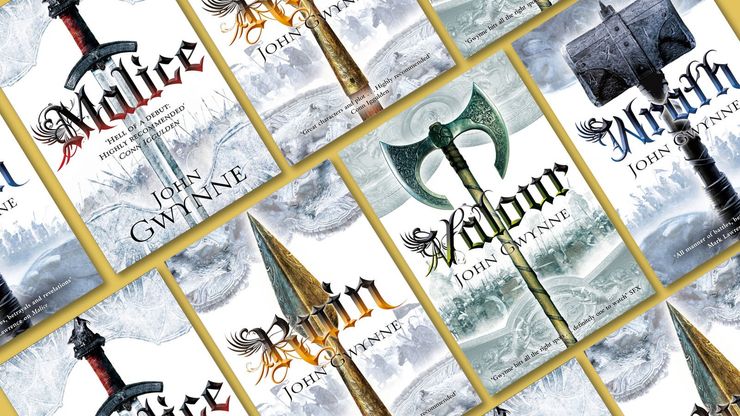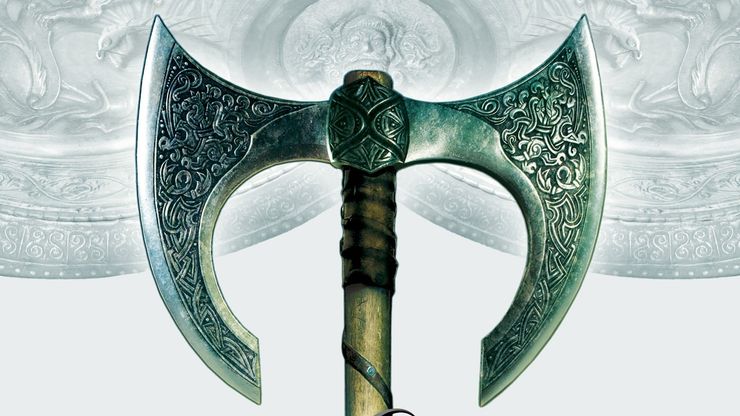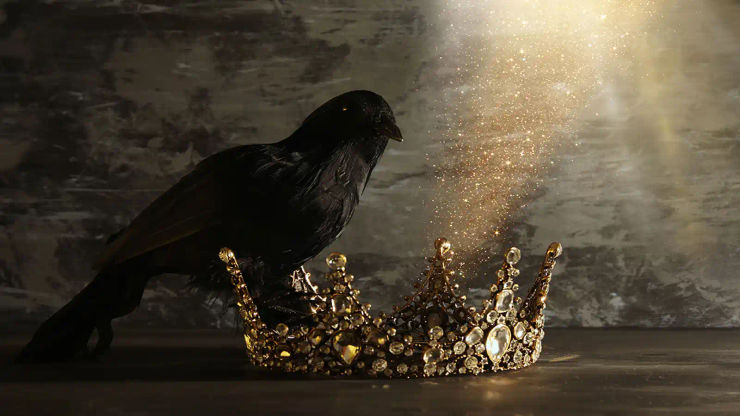Five questions with fantasy author John Gwynne
We dig deeper into the epic fantasy series The Faithful and the Fallen, including Malice, Valour, Ruin and the final conclusion Wrath.

We asked author John Gwynne five questions about everything from writing, to his inspiration and his favourite moments.
Discover our edit of the best fantasy books of all time.
Our FAVOURITE author photo (below) is one of you on your 'throne', resplendent with giant axe and huge dogs! Can you tell us the story of how that photo came to be?

It’s really lovely to hear that. The photo session was a lot of fun, and there are plenty more, featuring the whole Gwynne clan.
Really it was just a moment of madness. My family and I are all fans of ancient history and we’ve spent a lot of time visiting castles and historic sites. We’re also very fortunate in that Europe’s biggest medieval festival happens every year right on our doorstep, at Herstmonceux Castle. That’s where our inspiration came from really. We’d all love to be re-enactors, but life with my daughter Harriett, who is profoundly disabled, can limit that somewhat, so we keep ourselves to visiting local castles and events, and compensated with the photoshoot that my author photo came from. It was a great afternoon of fun-in-the-sun, the photos taken by one of my oldest mates and a budding amateur photographer, Andrew Campbell.
Everyone got into the spirit of it very easily – there was almost a beheading, but I won’t talk about that. The dogs loved it, too. Trinity, the Akita that looks like a wolf, was my original inspiration for Storm in my books – a more loyal and faithful hound you’d never find.
Your books feel as much historical as fantastical in some ways, with a genuine sense of myth and legend woven through them. What are the historical and fantastical influences behind the Faithful and the Fallen series?
I did a lot of research before I started writing The Faithful and the Fallen. The only way I knew how to write was how I’d learned at university, with the golden rule being to read, read, and then read some more. So I did. Ancient history and mythology were really the cornerstones of The Banished Lands and the peoples and creatures inhabiting it. Very early on in my reading, I was drawn to Caesar’s Gallic War, the Roman invasion of Briton, Boudicca’s revolt, as well as Celtic and Norse mythology.
I wanted my world to feel almost like an alternative ancient Europe, one where the line between history and myth was blurred, a world where the mythical tribes of giants that inhabited Briton were a reality, not gods, but Clans, people with their own agendas, loves, hates, dreams and fears. I hoped that the history and mythology would seep through and give my characters and plot a grounded sense of history and reality.

What have been the main challenges in terms of writing this series?
Well, keeping tabs on the growing cast list was an issue! My own fault, I know. And every character has their own history within the story, their own battle scars – literal and metaphorical – that have to be remembered and built upon. You can’t have a character take an arrow in the shoulder at the end of one book only to come out immediately swinging his sword in the next. Fortunately, some major POVs die in this one, (or unfortunately, depending on what you think of the characters!) so that makes it a little easier to keep tabs on the living!
Juggling character, plot and pace is always difficult. I try to tie character building in with events, so that both are happening simultaneously, keeping the plot moving forward and the characters growing.
Also, especially during the first half of Ruin, I felt the plots and characters moving in directions I hadn’t originally envisaged, and there were more opportunities to take their stories in new, wider directions – it’s a big world, after all, with a fair chunk of it unexplored. About halfway through I had to make a decision to either rein the book in or let it go and consider the story growing to extra volumes (I’d always planned four, and never really wanted it to be more than that). I decided to pull it back in, steer it back on to its original course. Looking back it feels like the right decision – to me now the book feels like the pace builds evenly towards a climactic and dramatic ending (I hope!)
As you've been through the mill of two books now, you're a debut author no more. What do you think you've learned as a writer that you've been able to bring to this book?
Crikey, I still think of myself as winging it!
Thinking back on it I have learned a lot – working with the amazing editors and team at Tor UK there’d have to be something wrong with me if I hadn’t learned anything from that wealth of talent.
One of the things that come to mind in Malice was a tendency to over-write. Too much of everything – description of landscapes, too much and/or irrelevant detail during dialogue, every move in a fight scene – so hopefully there was less of that in Ruin. Judging by the lower amounts of editorial red pen I do seem to be making progress there.
What's your favourite dramatic moment in the book?
I’m not very good at choosing just one. As dramatic moments go, there are quite a few in Ruin – more I think than in Malice and Valour. There were a number of scenes that I really enjoyed writing. My son Edward is my first reader and his reactions are often a good gauge on how scenes have come out. For example, tears = good scene. Anger = good scene. Laughter = good scene.
So here are a few scenes that I especially enjoyed writing, and which evoked a strong response from Ed.
I really enjoyed writing the battle sequence at Gramm’s Hold, where a few POVs converged at the same time, and some giant bears got in on the act. Ed liked that one.
Also, there’s a scene before the gates of Drassil, a duel, that I really enjoyed writing and that Ed seemed to enjoy. He was re-enacting moves upon his younger brother Will, anyway.
And the end, that includes both a twist that I hope most people didn’t see coming and a fight in the woods between Corban and Storm and some angry giants. That felt like it came out well. Ed cried. (He may want to hurt me for writing this!)
Like I said, I’m really bad at choosing favourite moments! I guess I’ll have to wait and see what readers think about that question.









